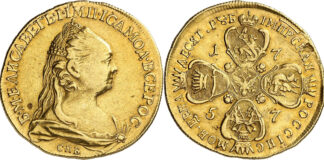
In early modern times, coins were minted that were intended to be used for payment purposes in regular circulation. On the other side, there were coins minted with the sole purpose of honouring special services rendered by special people. The 20-fold Basel ducat, which will be offered by Numismatica Genevensis on 14 November 2022 with an estimate of 600,000 Swiss Francs, was created in the middle of the 18th century for the latter reason. We do not know whether the municipal government of Basel used it to reward a diplomat for valuable services for the benefit of the city or whether it was maybe used to compensate for the services of a high Basel official. What we do know, however, is that a lot of effort was put into the creation of special coins like this one.
To produce this exceptional piece, the craftsmen used the dies of the 1741 taler. The latter had been created by the young but gifted engraver Johann Jakob Handmann (1711-1786). We can see his initials on the right below the city view. Handmann was from a famous Basel family of artists, whose best-known member was his brother, the portraitist Emanuel Handmann, who was internationally renowned at the time. Johann Jakob Handmann, who exclusively worked as an engraver, used his superior skill to create a vivid view of Basel’s Rhine Bridge looking downstream for the 1741 representative taler.
The coin shows everything the then about 20,000 Basel citizens were proud of. We can see a detailed city view of the major Rhine metropolis with the Rhine Bridge at the centre, above it the name of the city in a lavishly decorated cartouche. Above are the coats of arms of the Basel-dominated boroughs of Ramstein, Liestal, Waldenburg, Farnsburg, Homburg, Münchenstein, Pratteln and Riehen. Below the city view, the exergue is filled with a decorative composition of cornucopia and laurel branch. While the cornucopia represents the abundance that came to the city thanks to trade, the laurel branch symbolizes that the city successful asserted its independence from the bishop and France.
This affirmation was all the more important because, just one year earlier, numerous Basel citizens had been involved in the dispute between the prince-bishop of Basel and his subjects, which resulted in an intervention of French troops. In April 1740, the French defeated the insurgents. There was the immediate danger of the military conflict spilling over into Basel territory, but this could be prevented at the last minute.
The reverse features the supporter of the Basel coat of arms: a mighty basilisk. The basilisk, which is also referred to as king of snakes, is a mythological hybrid of snake and rooster that – depending on the tradition – kills with its breath or petrifies with its gaze. It holds the Basel coat of arms in a baroque-style cartouche with the Basel staff. Around it, the (translated) Basel motto reads: Lord, keep us in peace.

The question of for whom this wonderful coin, which will be auctioned off by Numismatica Genevensis on 14 November 2022, was created remains a mystery. What we do know is that it is a treasury of utmost rarity. Even off-metal strikes in gold from taler dies are extremely rare. But a multiple coin with the weight of 20 ducats is about unique. In addition, its quality was certified by the independent grading company NGC as MS65PL. That is exceptional for an 18th-century coin. Thus, this coin is of better quality than the only other known specimen in private hands as well as the specimen which was purchased by the Swiss National Museum in 1964.
This coin and other spectacular specimens can be found in the Numismatica Genevensis auction.
Here you can read a comprehensive auction preview.
Heavy and spectacular gold coins were often given to important people.
In the 19th century, gold became the most important coinage metal. Learn more about the circumstances of that time.





